Birds in Castilla are a source of great fascination and beauty. The region is home to various species, from songbirds to eagles. Some species are native to Castilla, while others migrate through the area during parts of the year.
With its diverse landscape, Castilla offers something for everyone, from the avid birdwatcher to the casual observer. The warm climate and abundant water sources make the area particularly attractive to many species of birds.
Whether you’re looking for a peaceful morning walk or an afternoon of birdwatching, you’re sure to have a rewarding experience in Castilla.
24 Birds to Watch in Castilla
If you are a bird lover, you might visit Castilla, a region in Spain that boasts a rich diversity of avian life. Castilla is home to many species of birds, some of which are rare, endangered, or endemic.
Here are 24 birds that you can watch in Castilla.
1. Mallard
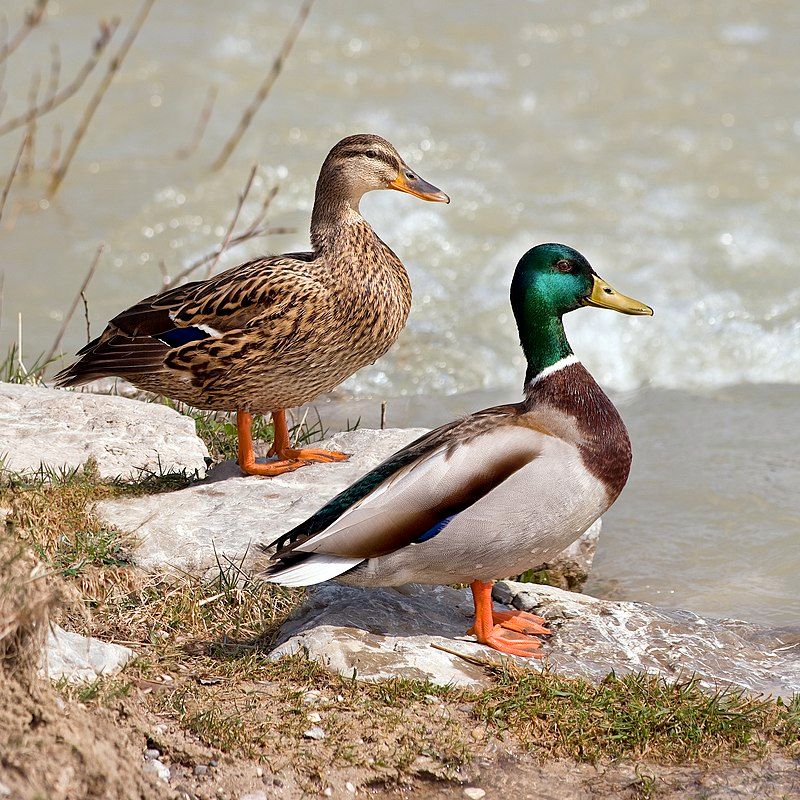
The Mallard or wild duck is a species of dabbling duck widely distributed across the temperate and subtropical regions of the Americas, Eurasia, and North Africa.
It is an incredibly adaptable species and has been introduced to numerous other countries beyond its natural range.
This includes New Zealand, Australia, Peru, Brazil, Uruguay, Argentina, Chile, Colombia, the Falkland Islands, and South Africa. The Mallard is a highly successful species due to its ability to inhabit various habitats, from wetlands to ponds, rivers, and lakes.
It can also survive in rural and urban areas, making it an even more widespread species.
The Mallard is a rather opportunistic feeder, eating a variety of vegetation and animal matter, including aquatic invertebrates, grains, grasses, and berries. The Mallard is a famous game bird and is hunted in many places across the world.
It is also frequently seen in parks and backyards, where it often comes to feed on any birdseed that may be left out.
The Mallard can also be a nuisance to farmers, as it can cause damage to crops. The Mallard is a significant species for the conservation of wetlands, as it is an indicator species of the health of its environment.
This is due to its wide range and the fact that it is relatively tolerant of human disturbance. The Mallard is also necessary for maintaining biodiversity, as it helps keep insect populations balanced.
| Kingdom | Animalia |
| Phylum | Chordata |
| Class | Aves |
| Order | Anseriformes |
| Family | Anatidae |
| Genus | Anas |
| Species | A. platyrhynchos |
2. Greater Flamingo
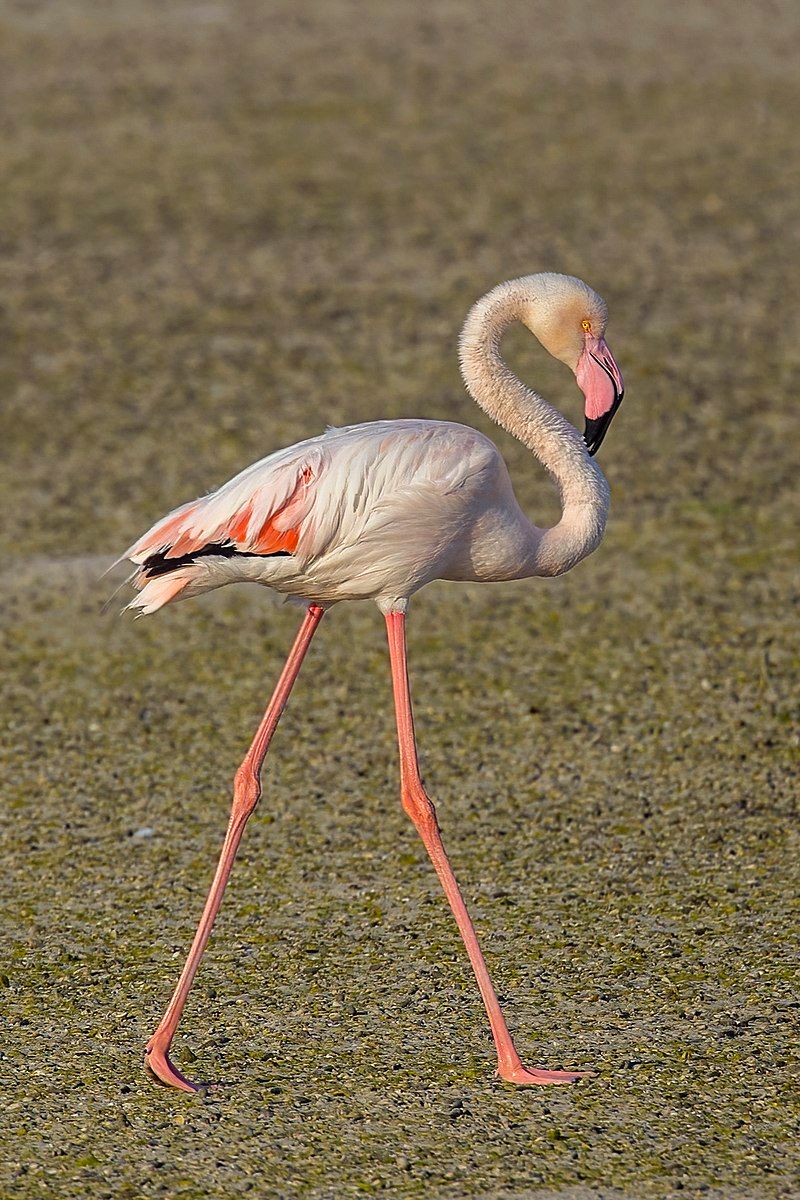
The greater flamingo is the most widespread and significant species of the family. It is a widespread species in the Old World, which refers to the region encompassing Europe, Asia, and Africa.
Greater flamingos can be found in various habitats across Northern and Sub-Saharan Africa, the Indian Subcontinent, the Middle East, the Levant, the Persian Gulf, the Gulf of Aden, the Red Sea, and the Mediterranean countries of Southern Europe.
They are often seen in shallow lagoons, estuaries, and mudflats, feeding on small creatures such as shrimp and brine shrimp. They also inhabit mangrove swamps, salt pans, and other saline wetlands.
The greater flamingo is an elegant bird with its large size, long neck, and bright pink plumage. It is a friendly bird and is often seen in large flocks.
They are a vital part of the ecosystems in which they live and help to keep the natural balance of their environment by consuming fish, crustaceans, and other aquatic organisms.
| Kingdom | Animalia |
| Phylum | Chordata |
| Class | Aves |
| Order | Phoenicopteriformes |
| Family | Phoenicopteridae |
| Genus | Phoenicopterus |
| Species | P. roseus |
3. Golden Eagle
The golden eagle is a magnificent bird of prey found in various regions of the Northern Hemisphere. It is the most widespread species of eagle in the world and is well-known for its impressive size and beautiful wingspan.
It is a member of the Accipitridae family of birds, which includes some of the most iconic birds of prey, such as hawks, kites, and vultures. Golden eagles are large birds with wingspans ranging from five to seven feet.
They have a brownish-gold coloring on the head, neck, and upper body, while the underparts are white. Their eyes are yellow and have long, yellow legs and yellow nails.
Golden eagles can fly at speeds of up to 150 mph and soar to great heights. Golden eagles primarily feed on small mammals, such as rabbits or hares, but they also eat birds, reptiles, and fish.
They hunt from the air by diving, seizing their prey with their talons, or using their mighty wings to knock their prey off balance. In addition to being a mighty hunter, the golden eagle symbolizes strength and courage in many cultures.
They are often used as symbols of power and honor, and their impressive size and beauty make them a favorite of birdwatchers and wildlife photographers.
| Kingdom | Animalia |
| Phylum | Chordata |
| Class | Aves |
| Order | Accipitriformes |
| Family | Accipitridae |
| Genus | Aquila |
| Species | A. chrysaetos |
4. Common Crane
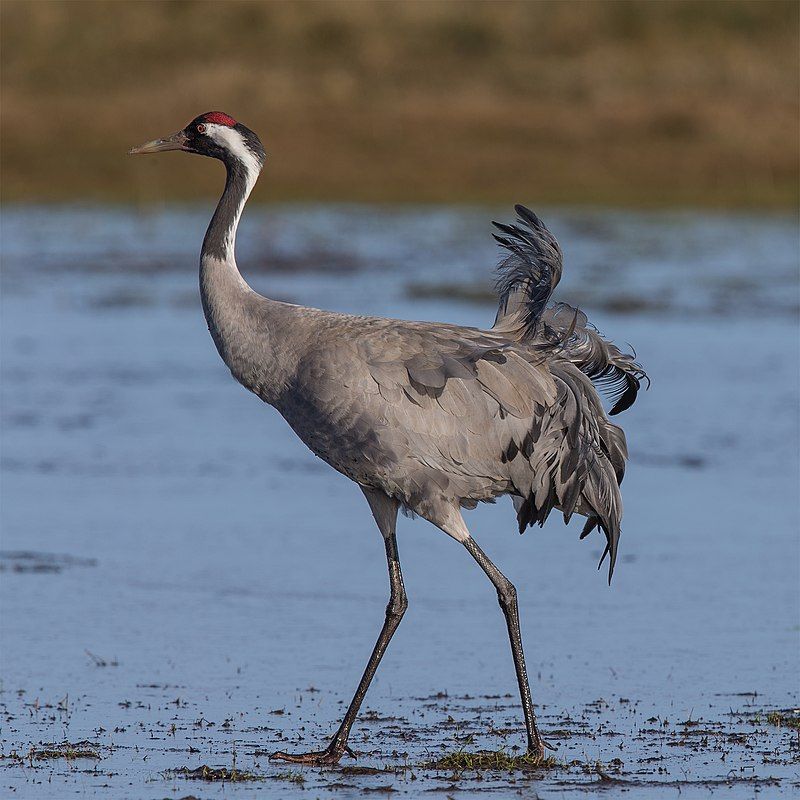
The standard crane, also called the Eurasian crane, is a bird of the Gruidae family, which includes all crane species. It is a medium-sized bird, usually between 115 and 130 centimeters tall and weighing between 4 and 5 kilograms.
It is the most widespread crane species in Europe, stretching from Scandinavia and Iceland in the north to Russia and Turkey in the East and Spain and France in the south.
The only other crane species regularly found in Europe are the demoiselle crane and the Siberian crane, both of which are found in the eastern regions of the continent.
The standard crane is a migratory species with a breeding range that is relatively small compared to its wintering range. During the summer, it breeds in northern and central Europe in countries such as Sweden, Finland, and Germany.
During winter, it moves south to the Mediterranean region, Spain, and the Middle East. The standard crane is an omnivorous species, feeding on various vegetation, insects, small mammals, and grain.
It prefers to inhabit wetland areas such as marshes, floodplains, and bogs and is a highly social bird, often forming large flocks during the winter months. The standard crane is listed as a species of most minor concern by the IUCN due to its large population and wide range.
| Kingdom | Animalia |
| Phylum | Chordata |
| Class | Aves |
| Order | Gruiformes |
| Family | Gruidae |
| Genus | Grus |
| Species | G. grus |
5. Great Bustard
The great bustard is a large, heavy-bodied bird belonging to the bustard family. It is the only living species in its genus, Otis.
It is a migratory species, breeding in open grasslands and farmland in various locations, from northern Morocco to Central Europe, East Asia, and Central Asia.
It prefers to inhabit relatively dry climates and is found in various habitats, such as grasslands, steppes, and agricultural lands. The great bustard is an omnivore, feeding on different plant and animal materials, including fruits, grains, and insects.
It is a solitary species, and males can be seen displaying during the breeding season to attract a mate. The great bustard is vulnerable on the IUCN Red List due to habitat loss, hunting, and other threats.
Conservation efforts, such as habitat preservation and captive breeding programs, are being undertaken to help protect this species.
| Kingdom | Animalia |
| Phylum | Chordata |
| Class | Aves |
| Order | Otidiformes |
| Family | Otididae |
| Genus | Otis |
| Species | O. tarda |
6. Eurasian Griffon
The Eurasian griffon vulture is a large bird of prey native to the Old World. It belongs to the Accipitridae family of birds, which includes hawks, eagles, and kites. This species is also known as the Griffon vulture, though this term can also refer to the genus as a whole.
It is important to note that the Eurasian griffon vulture is not the same species as the Rüppell’s griffon vulture or the Himalayan griffon vulture.
The Rüppell’s griffon vulture is a species native to sub-Saharan Africa, while the Himalayan griffon vulture is native to the Himalayan region of Asia. The Eurasian griffon vulture has a wingspan of up to 2.6 meters, making it one of the world’s most giant flying birds.
Its body is primarily light grey, with a white head and yellow bill. Its wings are broad and rounded, and it has a short tail. The Eurasian griffon vulture feeds mainly on carrion, which it can detect from a great distance.
It is also known to scavenge from garbage dumps or feed on the carcasses of dead animals. Overall, the Eurasian griffon vulture is an impressive bird species with an unmistakable appearance.
It must be distinguished from other vulture species, such as the Rüppell’s griffon vulture and the Himalayan griffon vulture, to ensure its conservation status is managed correctly.
| Kingdom | Animalia |
| Phylum | Chordata |
| Class | Aves |
| Order | Accipitriformes |
| Family | Accipitridae |
| Genus | Gyps |
| Species | G. fulvus |
7. Pin-tailed Sandgrouse
The pin-tailed sandgrouse is a medium-sized member of the sandgrouse family. Its head and neck are small and resemble those of a pigeon, while its body is sturdy and compact.
Its wings are long and pointed and white underneath, and its long tail helps it fly quickly and directly. These birds typically fly in flocks to watering holes at dawn, calling “kattar-kattar” as they go.
This call signals the flock to stay together and can be heard from some distance. The pin-tailed sandgrouse is a social bird, preferring to feed and fly in flocks.
This behavior helps it to survive in the wild, as the flock can spot potential predators from a distance and alert the others. The flock also gives the birds a sense of safety and protection, allowing them to travel further and forage for food.
| Kingdom | Animalia |
| Phylum | Chordata |
| Class | Aves |
| Order | Pterocliformes |
| Family | Pteroclidae |
| Genus | Pterocles |
| Species | P. alchata |
8. Rock Dove
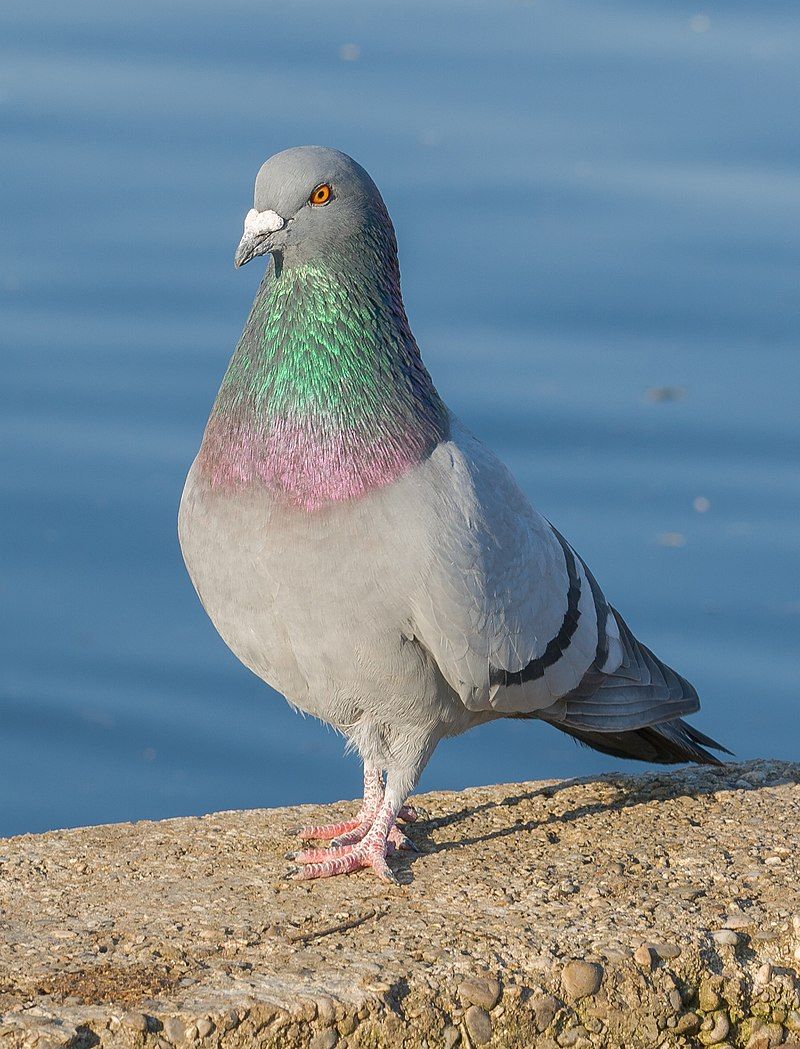
The rock dove, also known as the rock pigeon or common pigeon, is a bird species belonging to the Columbidae family. It is commonly called the “pigeon” in everyday language.
The domestic pigeon is a descendant of the rock dove, and due to escaped domestic pigeons, the populations of feral pigeons have grown significantly worldwide.
This is because the escaped domestic pigeons can procreate and contribute to the wild population, thus increasing the number of feral pigeons. As a result, feral pigeons can now be found in various habitats, such as urban areas, parks, and forests.
The rock dove is an adaptable species that can survive in many different environments, making it a successful species globally.
| Kingdom | Animalia |
| Phylum | Chordata |
| Class | Aves |
| Order | Columbiformes |
| Family | Columbidae |
| Genus | Columba |
| Species | C. livia |
9. Eurasian Blue Tit
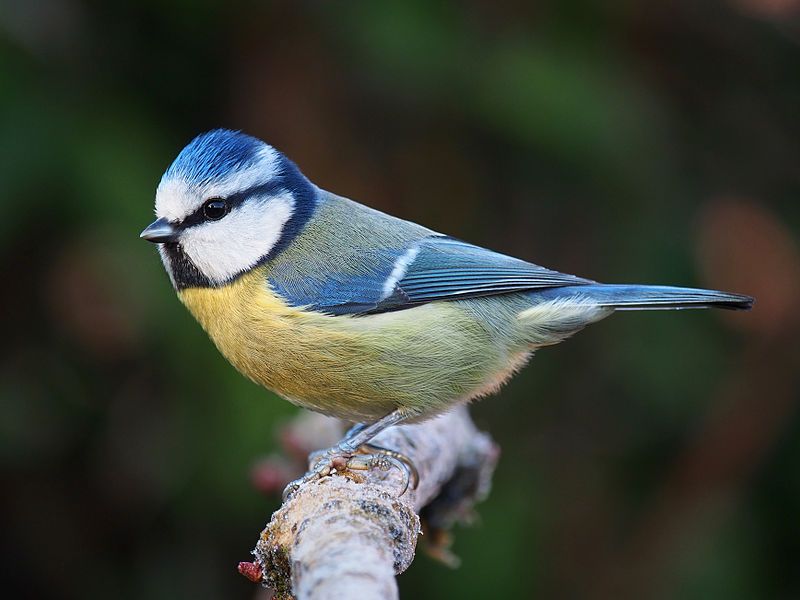
The Eurasian blue tit is a species of bird belonging to the Paridae family, which is more commonly known as the tit family. This bird species is easily recognizable due to its distinct blue and yellow plumage and small size.
It is a passerine bird, meaning it is of the order Passeriformes, the most significant order of birds, and includes most familiar species like sparrows, finches, and cardinals.
The Eurasian blue tit is a small bird, typically ranging from 11 to 12.5 cm in length and weighing between 8 and 14 grams.
It is a colorful bird with a bright blue head, yellow underparts, and a yellow line across its wings. The bird also has a black eyestripe and chin, and its wings and tail feathers are greyish-blue.
The male and female Eurasian blue tits are generally similar in appearance, although the males have slightly brighter plumage than the females. The Eurasian blue tit is native to much of Europe and parts of western and central Asia.
It prefers deciduous and mixed forests and is commonly found in gardens, parks, and other areas with trees. It feeds mainly on insects, spiders, and other small invertebrates and will also feed on seeds and fruits in the winter.
The Eurasian blue tit is mainly well known for its acrobatics as it searches for food, often hanging upside down to reach insects inside crevices.
Overall, the Eurasian blue tit is a distinctive and easily recognizable bird due to its brightly colored plumage, small size, and acrobatic behavior.
It is a widespread species and an essential part of many ecosystems.
| Kingdom | Animalia |
| Phylum | Chordata |
| Class | Aves |
| Order | Passeriformes |
| Family | Paridae |
| Genus | Cyanistes |
| Species | C. caeruleus |
10. Common Wood Pigeon
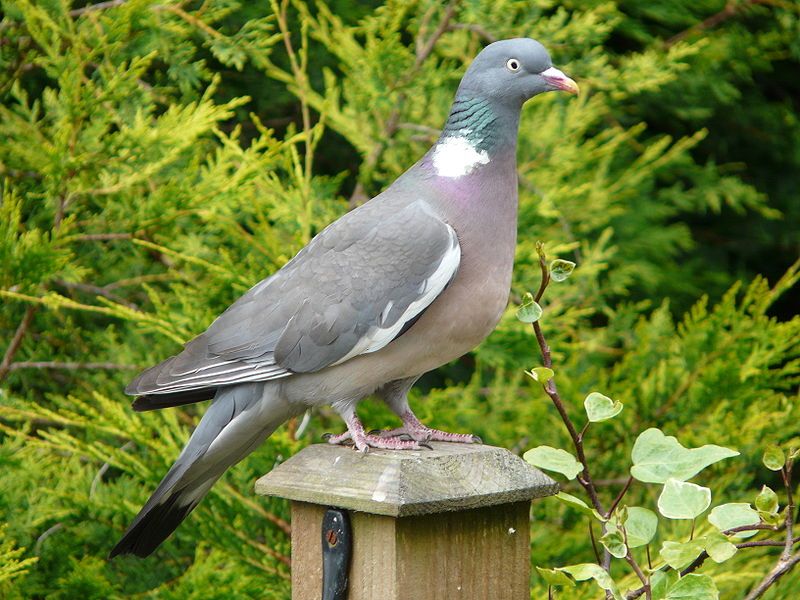
The standard wood pigeon is a member of the dove and pigeon family that is found in the western Palearctic region. It has a variety of names, including wood pigeons, and is part of the Columba genus, which includes other doves and pigeons, such as the rock dove.
This species is quite large and can inhabit a wide range of habitats. It is found in forests, parks, and other open spaces. The wingspan of the common wood pigeon is typically between 34 and 39 inches.
It is a social bird and can often be seen in groups. Its diet mainly consists of grains, fruits, and other vegetation. The standard wood pigeon is an important species for both humans and wildlife, providing food for other animals and a source of food for humans.
The population of this species is stable, though it is threatened by habitat loss and hunting.
| Kingdom | Animalia |
| Phylum | Chordata |
| Class | Aves |
| Order | Columbiformes |
| Family | Columbidae |
| Genus | Columba |
| Species | C. palumbus |
11. Common Quail
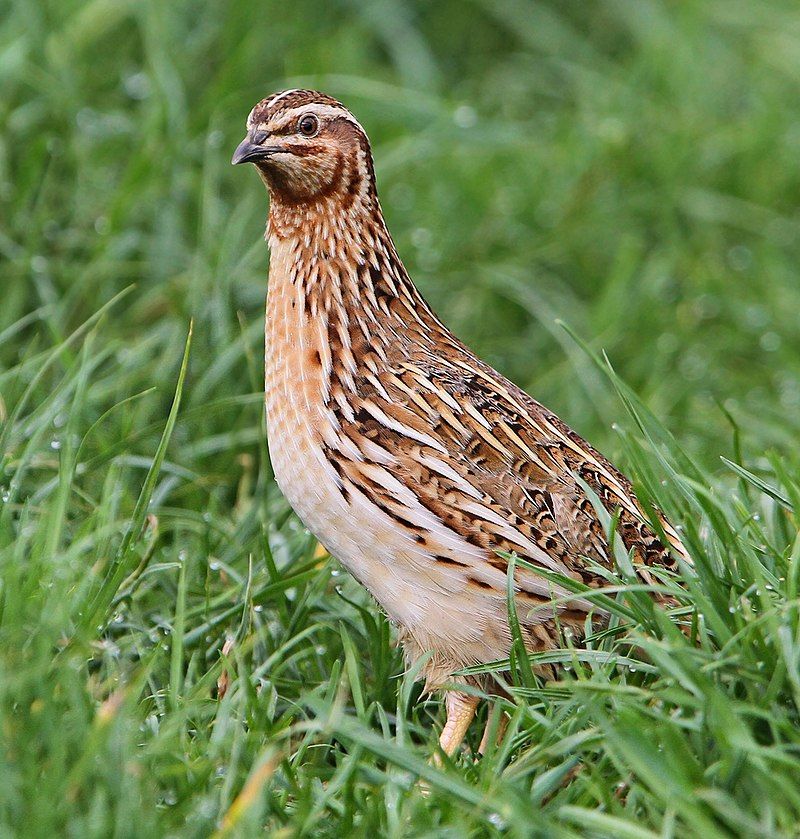
The common quail, also known as the European quail, is a small bird belonging to the pheasant Phasianidae family. It is mainly migratory, meaning it spends the year in different locations.
During the summer months, it breeds in the western Palearctic region, which includes Europe, parts of North Africa, and western Asia.
During winter, it migrates to warmer climates, such as Africa and southern India. This quail species is notable for its distinct call, consisting of three repeated chirps.
Although the quail is not easy to spot, its call is recognizable and can be heard from a distance. This makes identifying it more accessible than other birds, rarely seen but never heard.
| Kingdom | Animalia |
| Phylum | Chordata |
| Class | Aves |
| Order | Galliformes |
| Family | Phasianidae |
| Genus | Coturnix |
| Species | C. coturnix |
12. Red-crested Pochard
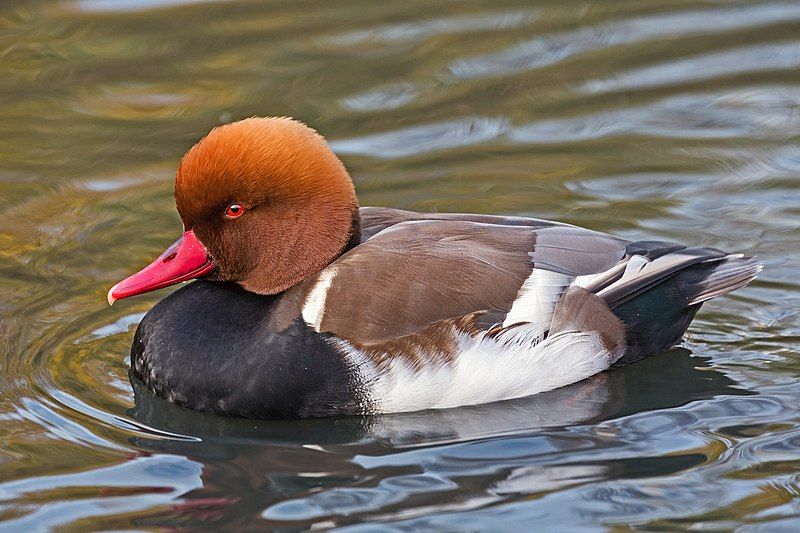
The red-crested pochard is a species of diving duck native to many parts of the world. It is easily identifiable by its bright red crest atop its head. The scientific name of this species is derived from two ancient languages: Greek and Latin.
In Greek, the species is known as “Netta”, which translates to “duck”; whereas, in Latin, it is referred to as “Rufina” which means “golden-red”. This is an apt description of this species due to its vibrant red crest.
The red-crested pochard is an essential species in its ecosystems, as it is a food source for many predatory species. It is also a famous game bird hunted by many people throughout its range.
Its scientific name aptly reflects its appearance and its importance in its environment.
| Kingdom | Animalia |
| Phylum | Chordata |
| Class | Aves |
| Order | Anseriformes |
| Family | Anatidae |
| Genus | Netta |
| Species | N. rufina |
13. Ferruginous Duck
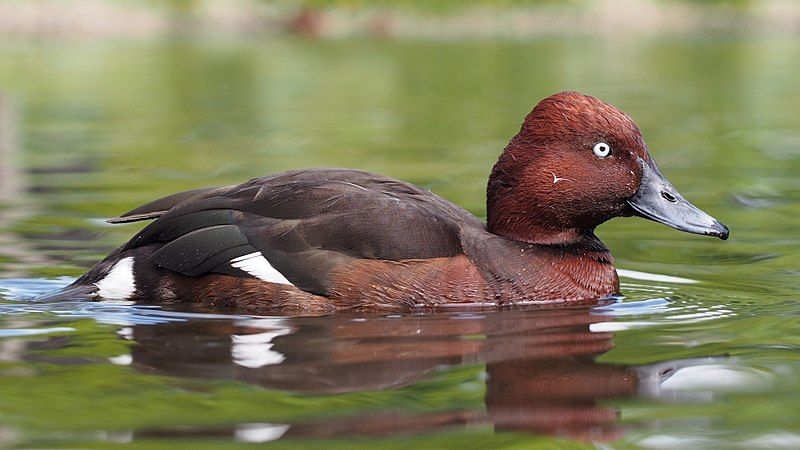
The ferruginous duck is a medium-sized diving duck that is found throughout Eurosiberia.
Its scientific name is derived from two sources: Lithuania, an unidentified seabird mentioned by ancient authors such as Hesychius and Aristotle, and york, the Russian name for a duck.
This duck species is also known as ferruginous, a common white-eye or white-eyed pochard. The ferruginous duck is a unique species of bird that is quite distinct from other duck species. Its feathers are a rich brown-red color, known as ferruginous.
It has a black-and-white striped head and a white eye ring. It has a long, pointed bill, webbed feet, and a muscular chest. The ferruginous duck prefers to live in shallow, freshwater wetlands like marshes and ponds.
It is also fond of slow-moving rivers and lakes. The ferruginous duck is an omnivorous species that feeds on various aquatic animals, such as insects, crustaceans, worms, and small fish. It will also eat plant matter, such as seeds, leaves, and grains.
This duck species is essential to the local ecosystem, as it helps control insect and small fish populations. The ferruginous duck is a social species, and they often gather in large flocks.
They are migratory birds, and they will fly south during the winter to warmer climates. They breed during the summer and lay their eggs in caves, hollow logs, or nesting boxes.
The ferruginous duck is an important species, and it is listed as Near Threatened on the IUCN Red List.
| Kingdom | Animalia |
| Phylum | Chordata |
| Class | Aves |
| Order | Anseriformes |
| Family | Anatidae |
| Genus | Aythya |
| Species | A. nyroca |
14. Western Capercaillie
The western capercaillie is a large and impressive bird that has many names. It is also known as the Eurasian capercaillie, wood grouse, heather cock, cock-of-the-woods, or simply capercaillie. It is a member of the grouse family and is the largest of all extant grouse species.
A specimen of the western capercaillie, recorded in captivity, had an impressive weight of 7.2 kilograms. This makes it one of the heaviest known birds of its kind. The capercaillie of the West is an incredible species. Its size and color quickly identify it.
It has a mottled gray-brown back and is dotted with black and white markings on its breast. The male has a black throat and a white stripe on his neck. The male also has a large fan-shaped tail that attracts females during mating season.
The female western capercaillie is slightly smaller than the male and is usually brown with black and white markings. The capercaillie of the West lives in forested areas and prefers coniferous and mixed forests. It feeds mainly on plants, insects, and small mammals.
Although it can be found in many places, the western capercaillie is considered a threatened species due to habitat destruction and hunting. The capercaillie of the West is an impressive bird with an essential place in the natural world.
Its size, color, and habitat preferences make it a unique and fascinating species. Its impressive weight of 7.2 kilograms makes it one of the heaviest known birds.
The western capercaillie species should be appreciated and protected for future generations.
| Kingdom | Animalia |
| Phylum | Chordata |
| Class | Aves |
| Order | Galliformes |
| Family | Phasianidae |
| Genus | Tetrao |
| Species | T. urogallus |
15. Eurasian Collared Dove
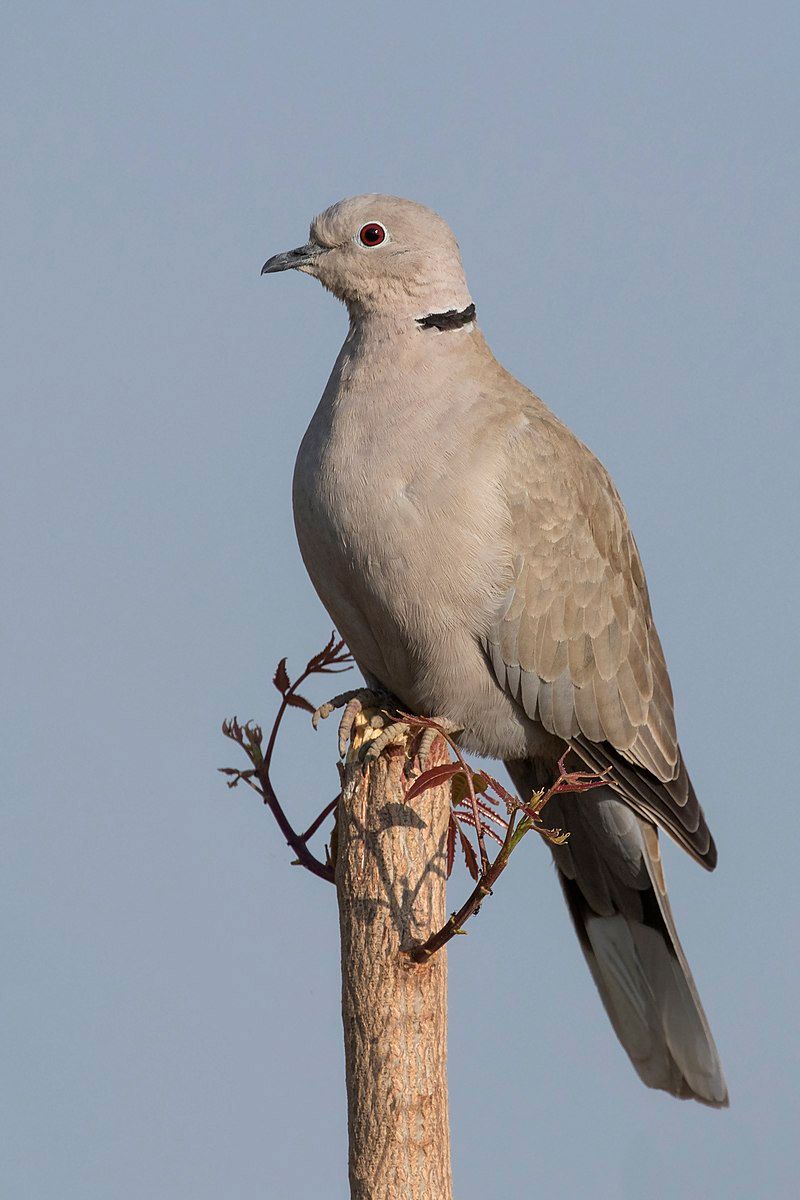
The Eurasian collared dove is a species native to Europe and Asia. Its native range encompasses a vast expanse, stretching from the British Isles in the West to Japan in the East.
The species was introduced to North America and various islands in the Caribbean during the 20th century, establishing a large and widespread population across these regions.
The Eurasian collared dove is a medium-sized dove, typically measuring 12-14 inches long. Its plumage is light brown on the body with darker brown wings and tail. The species is identified by the distinctive white half-collar on its neck.
The Eurasian collared dove is a highly adaptable species that can live in various habitats, including forests, woodlands, agricultural land, and urban areas. The species has a broad diet, which includes seeds, grains, fruits, and insects.
| Kingdom | Animalia |
| Phylum | Chordata |
| Class | Aves |
| Order | Columbiformes |
| Family | Columbidae |
| Genus | Streptopelia |
| Species | S. decaocto |
16. Stock Dove
The stock dove is a species of bird found in the family Columbidae, which includes doves and pigeons. It is native to the western Palearctic, a biogeographic region covering Europe, North Africa, and parts of Asia.
The stock dove is medium-sized, mainly grey, with a white rump patch, white wing bars, and a pink bill. Its wings are long and pointed, and its tail is short and rounded.
Its habitat includes forests, woodlands, and open landscapes, and it is often seen in fields and gardens. It feeds on seeds and grains and visits bird feeders for supplementary food. It is a friendly and vocal bird and can often be heard cooing and calling in flight.
It is a relatively common bird, and its population is considered stable.
| Kingdom | Animalia |
| Phylum | Chordata |
| Class | Aves |
| Order | Columbiformes |
| Family | Columbidae |
| Genus | Columba |
| Species | C. oenas |
17. White-headed Duck
The white-headed duck is a small diving duck typically measures 45 cm long. The male has a distinctive appearance: a white head and black crown, a blue bill, and reddish-grey plumage. The female is a bit duller in color, with a dark bill.
This species of duck breeds in lakes with open water and dense vegetation along the edges. The vegetation provides cover for the duck to hide from predators and a place to nest. The open water is necessary for the duck to find food, such as aquatic plants and small fish.
This species is highly dependent on its wetland habitat for breeding and survival.
| Kingdom | Animalia |
| Phylum | Chordata |
| Class | Aves |
| Order | Anseriformes |
| Family | Anatidae |
| Genus | Oxyura |
| Species | O. leucocephala |
18. Red-knobbed Coot
The Red-Knobbed Coot, or Crested Coot, is a bird species belonging to the Rallidae family. It is a resident breeder, meaning it has lived in a particular area for a long time and can be found across much of Africa and in the southernmost part of Spain.
It prefers to make its home near freshwater lakes and ponds. The Red-Knobbed Coot builds its nest from dead reeds, which it typically places near the water’s edge, though it may also construct a floating nest on the water. Usually, the bird will lay about seven eggs.
This species is exceptionally social and can often be found in large groups, making it a popular birdwatching destination.
| Kingdom | Animalia |
| Phylum | Chordata |
| Class | Aves |
| Order | Gruiformes |
| Family | Rallidae |
| Genus | Fulica |
| Species | F. cristata |
19. Greylag Goose
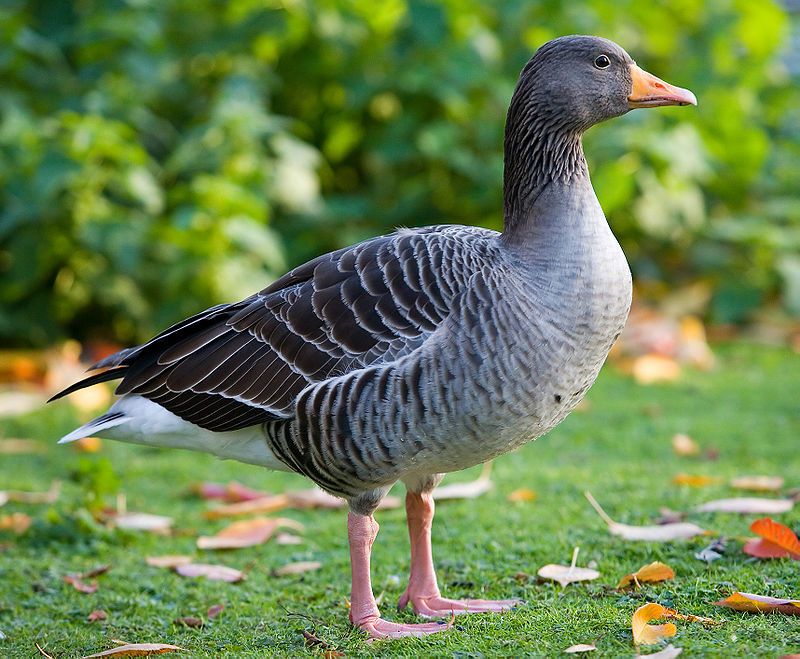
The greylag goose is a species of large goose in the family Anatidae and is the type species of the genus Anser. It is easily identified by its distinct plumage, a combination of gray and white mottled and barred feathers.
The beak is vibrant orange, and the legs are bright pink. This unique combination of colors makes the greylag goose stand out from the other species of Anatidae. The greylag goose is native to Europe, Asia, and some parts of North Africa.
It prefers to inhabit wetlands like marshes, lakes, and riverbanks. It is a strong flyer and can often be seen migrating between its breeding grounds in the summer and its wintering grounds in the winter.
The greylag goose feeds mainly on plant material such as grasses, sedges, and grains. It also eats insects, larvae, and worms. During the breeding season, the male greylag goose protects its mate and young by making loud honking sounds.
These loud honks are also used to warn other geese of potential danger. The greylag goose is a vital part of the waterfowl family Anatidae and plays an essential role in the ecosystem. It is a symbol of a healthy habitat and is an indicator of a wetland’s health.
It is also a popular species among birdwatchers and photographers.
| Kingdom | Animalia |
| Phylum | Chordata |
| Class | Aves |
| Order | Anseriformes |
| Family | Anatidae |
| Genus | Anser |
| Species | A. anser |
20. Egyptian Vulture
The Egyptian Vulture is a type of Old World vulture and the only member of its genus, Neophron. It is a small bird often called the white scavenger vulture or pharaoh’s chicken.
The Egyptian Vulture has a wide distribution range, stretching from the Iberian Peninsula and North Africa to India. It is considered one of the most widespread vulture species in the world, with an estimated population of 30,000 and 50,000 individuals.
The Egyptian Vulture is primarily a scavenger, feeding on carrion, eggs, and other small animals. It is also known to be an opportunistic feeder and will even feed on human waste occasionally.
Despite its wide range, the Egyptian Vulture is classified as endangered on the IUCN Red List due to a recent decline in population numbers.
Conservation efforts, such as the creation of protected areas and anti-poaching campaigns, are helping to restore the population of this majestic bird.
| Kingdom | Animalia |
| Phylum | Chordata |
| Class | Aves |
| Order | Accipitriformes |
| Family | Accipitridae |
| Genus | Neophron |
| Species | N. percnopterus |
21. Lesser Kestrel
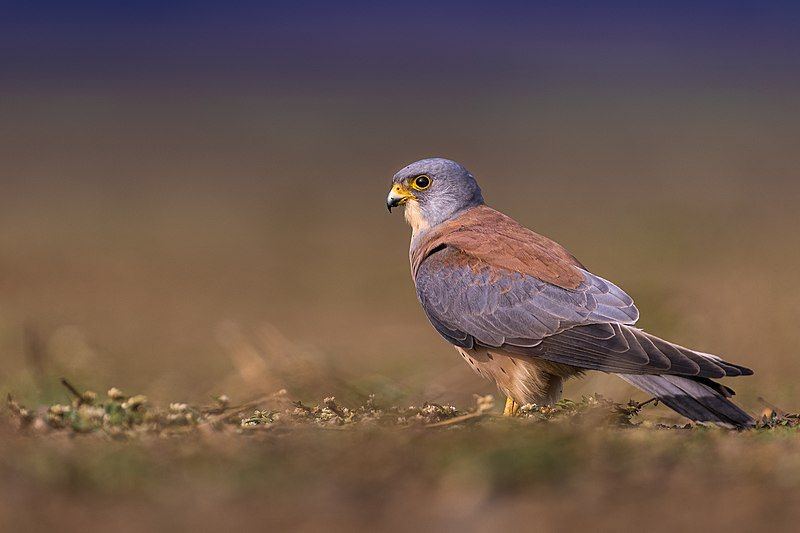
The lesser kestrel is a small falcon species that breeds mainly in the Mediterranean and extends its range across Afghanistan and Central Asia to China and Mongolia. During the summer, these birds migrate and travel as far south as Africa and Pakistan.
On rare occasions, some individuals may migrate as far as India and Iraq. Unfortunately, the lesser kestrel is considered a rare species north of its breeding range and is in decline in its European range.
Conservation projects are in place to help protect this species, promote population growth, and reduce the rate of decline.
| Kingdom | Animalia |
| Phylum | Chordata |
| Class | Aves |
| Order | Falconiformes |
| Family | Falconidae |
| Genus | Falco |
| Species | F. naumanni |
22. Little Grebe
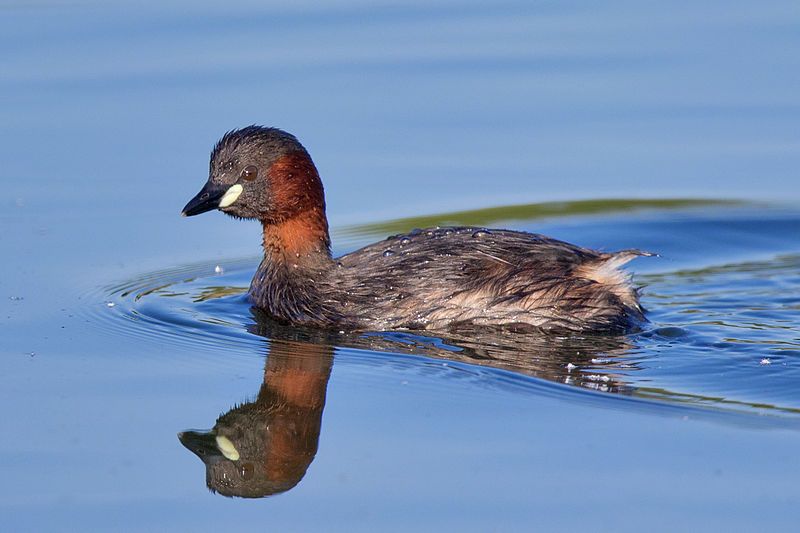
The little grebe, scientifically known as tachybaptus ruficollis, is a water bird that belongs to the grebe family. Its genus name is derived from Ancient Greek, with “tachus” meaning “fast” and “bapto” meaning “to sink under”.
Its species name, “ruficollis,” is derived from Latin, with “Rufus” meaning “red” and “Collis” meaning “neck,” which is further derived from the Latin word “collum,” meaning “neck.”
The little grebe is commonly referred to as a dabchick and is known to be minor, agile, and able to move quickly in water. Its red neck distinguishes it from other species of birds within its family, making it easily recognizable.
| Kingdom | Animalia |
| Phylum | Chordata |
| Class | Aves |
| Order | Podicipediformes |
| Family | Podicipedidae |
| Genus | Tachybaptus |
| Species | T. ruficollis |
23. Black-bellied Sandgrouse
The black-bellied sandgrouse is a bird belonging to the sandgrouse family. It is of medium size and can be found in several different regions.
The nominate race, which refers to the species in its original form, inhabits Iberia, northwest Africa, the Canary Islands, Turkey, Iran, Cyprus, and Israel. There is also an eastern form of the species known as P. o.
Irenaeus is found in Kazakhstan, western China, and northern Pakistan. In addition to its wide range, the black-bellied sandgrouse is known for its ability to fly long distances for food and water.
This has enabled it to survive in harsh conditions and inhabit multiple habitats. The species has adapted to various climates and can be found in desert and semi-arid environments.
| Kingdom | Animalia |
| Phylum | Chordata |
| Class | Aves |
| Order | Pterocliformes |
| Family | Pteroclidae |
| Genus | Pterocles |
| Species | P. orientalis |
24. Red-legged Partridge
The red-legged partridge is a gamebird species belonging to the pheasant family Phasianidae. This family is part of the order Galliformes, a large group of mainly gallinaceous birds.
Commonly known as the French partridge, the red-legged partridge is often distinguished from the English or grey partridge. This species is usually found in areas with a mild climate, such as parts of Europe, North Africa, and western Asia.
It feeds mainly on seeds, berries, and other small invertebrates. The red-legged partridge is a reasonably popular gamebird and is often bred and released for hunting purposes. It is also highly valued in the pet trade due to its attractive plumage and distinctive call.
| Kingdom | Animalia |
| Phylum | Chordata |
| Class | Aves |
| Order | Galliformes |
| Family | Phasianidae |
| Genus | Alectoris |
| Species | A. rufa |
Conclusion
Birds in Castilla are an essential part of its biodiversity. They provide crucial ecosystem services, such as pollination, pest control, and seed dispersal. Many species of birds, both native and migratory, rely on Castilla’s habitats for survival.
Unfortunately, human activities, such as deforestation and development, threaten many of these habitats.
Therefore, we must work to protect and restore habitats to ensure the continued survival of Castilla’s birds.